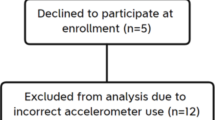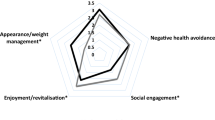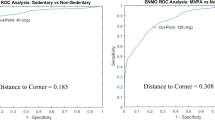Abstract
Study Design:
Descriptive cross-sectional study.
Setting:
The study was conducted in the Spinal Cord Injury Unit of the University Vall d’Hebron Hospital and in the Physical Education and Sports Department of the University of Valencia.
Objectives:
The aim of this study was to quantify the presence of comorbidities in spinal cord injury (SCI) subjects who did or did not perform regular physical activity (PA) and to identify the relationship between PA and the level of comorbidity.
Methods:
The sample consisted of patients with complete motor SCI (T2–T12), who were fitted with an accelerometer attached to the non-dominant wrist for a period of 1 week. The clinical and blood analytic variables were selected by an expert panel.
Results:
In the exploratory analysis, we have found differences in the total number of pathologies between active and inactive patients, with fewer total pathologies in the active patient group. An association was found between the PA level and diabetes mellitus ( ; P=0.047; φ=0.25). We also observed an association between the cardioprotector level of high-density lipoprotein (HDL)-cholesterol and PA level (
; P=0.047; φ=0.25). We also observed an association between the cardioprotector level of high-density lipoprotein (HDL)-cholesterol and PA level ( ; P=0.057; Φ0.24).
; P=0.057; Φ0.24).
Conclusions:
Our results suggest that patients considered active showed lower total comorbidity than inactive patients and higher protection levels against developing cardiovascular comorbidity.
Similar content being viewed by others
Log in or create a free account to read this content
Gain free access to this article, as well as selected content from this journal and more on nature.com
or
References
Bauman WA, Spungen AM . Carbohydrate and lipid metabolism in chronic spinal cord injury. J Spinal Cord Med 2001; 24: 266–277.
Gerhart KA, Bergstrom E, Charlifue SW, Menter RR, Whiteneck GG . Long-term spinal cord injury: functional changes over time. Arch Phys Med Rehabil 1993; 74: 1030–1034.
Washburn RA, Figoni SF . High density lipoprotein cholesterol in individuals with spinal cord injury: the potential role of physical activity. Spinal Cord 1999; 37: 685–695.
Hubli M, Gee CM, Krassioukov AV . Refined assessment of blood pressure instability after spinal cord injury. Am J Hypertens 2015; 28: 173–181.
Biering-Sørensen F, Jennum P, Laub M . Sleep disordered breathing following spinal cord injury. Respir Physiol Neurobiol 2009; 169: 165–170.
Lavela SL, Weaver FM, Goldstein B, Chen K, Miskevics S, Rajan S et al. Diabetes mellitus in individuals with spinal cord injury or disorder. J Spinal Cord Med 2006; 29: 387–395.
Buchholz AC, Martin Ginis KA, Bray SR, Craven BC, Hicks AL, Hayes KC et al. Greater daily leisure time physical activity is associated with lower chronic disease risk in adults with spinal cord injury. Appl Physiol Nutr Metab Physiol 2009; 34: 640–647.
Hetz SP, Latimer AE, Buchholz AC, Martin Ginis KA . Increased participation in activities of daily living is associated with lower cholesterol levels in people with spinal cord injury. Arch Phys Med Rehabil 2009; 90: 1755–1759.
Manns PJ, Chad KE . Determining the relation between quality of life, handicap, fitness, and physical activity for persons with spinal cord injury. Arch Phys Med Rehabil 1999; 80: 1566–1571.
Slater D, Meade MA . Participation in recreation and sports for persons with spinal cord injury: review and recommendations. NeuroRehabilitation 2004; 19: 121–129.
Glaser RM . Functional neuromuscular stimulation. Exercise conditioning of spinal cord injured patients. Int J Sports Med 1994; 15: 142–148.
Jacobs PL, Nash MS . Exercise recommendations for individuals with spinal cord injury. Sports Med Auckl NZ 2004; 34: 727–751.
Taylor AW, McDonell E, Brassard L . The effects of an arm ergometer training programme on wheelchair subjects. Paraplegia 1986; 24: 105–114.
Guyatt GH, Naylor CD, Juniper E, Heyland DK, Jaeschke R, Cook DJ . Users’ guides to the medical literature. XII. How to use articles about health-related quality of life. Evidence-Based Medicine Working Group. JAMA 1997; 277: 1232–1237.
Ginis KAM, Latimer AE, Arbour-Nicitopoulos KP, Buchholz AC, Bray SR, Craven BC et al. Leisure time physical activity in a population-based sample of people with spinal cord injury part I: demographic and injury-related correlates. Arch Phys Med Rehabil 2010; 91: 722–728.
WHO.. Obesity: preventing and managing the global epidemic. Report of a WHO consultation. World Health Organ Tech Rep Ser 2000; 894: 1–253.
García-Massó X, Serra-Añó P, García-Raffi LM, Sánchez-Pérez EA, López-Pascual J, Gonzalez LM . Validation of the use of Actigraph GT3X accelerometers to estimate energy expenditure in full time manual wheelchair users with spinal cord injury. Spinal Cord 2013; 51: 898–903.
Hiremath SV, Ding D, Farringdon J, Cooper RA . Predicting energy expenditure of manual wheelchair users with spinal cord injury using a multisensor-based activity monitor. Arch Phys Med Rehabil 2012; 93: 1937–1943.
Hicks AL, Martin Ginis KA, Pelletier CA, Ditor DS, Foulon B, Wolfe DL . The effects of exercise training on physical capacity, strength, body composition and functional performance among adults with spinal cord injury: a systematic review. Spinal Cord 2011; 49: 1103–1127.
Grundy SM, Brewer HB, Cleeman JI, Smith SC, Lenfant C, et alNational Heart, Lung, and Blood Institute. Definition of metabolic syndrome: report of the National Heart, Lung, and Blood Institute/American Heart Association conference on scientific issues related to definition. Arterioscler Thromb Vasc Biol 2004; 24: e13–e18.
Fritz CO, Morris PE, Richler JJ . Effect size estimates: current use, calculations, and interpretation. J Exp Psychol Gen 2012; 141: 2.
Anson CA, Shepherd C . Incidence of secondary complications in spinal cord injury. Int J Rehabil Res 1996; 19: 55–66.
Charlifue S, Lammertse DP, Adkins RH . Aging with spinal cord injury: changes in selected health indices and life satisfaction. Arch Phys Med Rehabil 2004; 85: 1848–1853.
Walter JS, Sacks J, Othman R, Rankin AZ, Nemchausky B, Chintam R et al. A database of self-reported secondary medical problems among VA spinal cord injury patients: its role in clinical care and management. J Rehabil Res Dev 2002; 39: 53–61.
Brinkhof MWG, Al-Khodairy A, Eriks-Hoogland I, Fekete C, Hinrichs T, Hund-Georgiadis M et al. Health conditions in people with spinal cord injury: Contemporary evidence from a population-based community survey in Switzerland. J Rehabil Med 2016; 48: 197–209.
Guerrero-Romero F, Rodríguez-Morán M . Relation of C-reactive protein to features of the metabolic syndrome in normal glucose tolerant, impaired glucose tolerant, and newly diagnosed type 2 diabetic subjects. Diabetes Metab 2003; 29: 65–71.
Ridker PM, Buring JE, Cook NR, Rifai N . C-reactive protein, the metabolic syndrome, and risk of incident cardiovascular events: an 8-year follow-up of 14 719 initially healthy American women. Circulation 2003; 107: 391–397.
Bauman WA, Spungen AM . Disorders of carbohydrate and lipid metabolism in veterans with paraplegia or quadriplegia: a model of premature aging. Metabolism 1994; 43: 749–756.
Lee MY, Myers J, Hayes A, Madan S, Froelicher VF, Perkash I et al. C-reactive protein, metabolic syndrome, and insulin resistance in individuals with spinal cord injury. J Spinal Cord Med 2005; 28: 20–25.
Jones LM, Legge M, Goulding A . Factor analysis of the metabolic syndrome in spinal cord-injured men. Metabolism 2004; 53: 1372–1377.
Liang H, Chen D, Wang Y, Rimmer JH, Braunschweig CL . Different risk factor patterns for metabolic syndrome in men with spinal cord injury compared with able-bodied men despite similar prevalence rates. Arch Phys Med Rehabil 2007; 88: 1198–1204.
Manns PJ, McCubbin JA, Williams DP . Fitness, inflammation, and the metabolic syndrome in men with paraplegia. Arch Phys Med Rehabil 2005; 86: 1176–1181.
Myers J, Lee M, Kiratli J . Cardiovascular disease in spinal cord injury: an overview of prevalence, risk, evaluation, and management. Am J Phys Med Rehabil Assoc Acad Physiatr 2007; 86: 142–152.
Nooijen CFJ, de Groot S, Postma K, Bergen MP, Stam HJ, Bussmann JBJ et al. A more active lifestyle in persons with a recent spinal cord injury benefits physical fitness and health. Spinal Cord 2012; 50: 320–323.
Expert Panel on Detection, Evaluation, and Treatment of High Blood Cholesterol in Adults. Executive Summary of The Third Report of The National Cholesterol Education Program (NCEP) Expert Panel on Detection, Evaluation, And Treatment of High Blood Cholesterol In Adults (Adult Treatment Panel III). JAMA 2001; 285: 2486–2497.
Bauman WA, Adkins RH, Spungen AM, Waters RL . The effect of residual neurological deficit on oral glucose tolerance in persons with chronic spinal cord injury. Spinal Cord 1999; 37: 765–771.
de Groot S, Post MW, Snoek GJ, Schuitemaker M, van der Woude LH . Longitudinal association between lifestyle and coronary heart disease risk factors among individuals with spinal cord injury. Spinal Cord 2013; 51: 314–318.
Moussavi RM, Ribas-Cardus F, Rintala DH, Rodriguez GP . Dietary and serum lipids in individuals with spinal cord injury living in the community. J Rehabil Res Dev 2001; 38: 225–233.
Brenes G, Dearwater S, Shapera R, LaPorte RE, Collins E . High density lipoprotein cholesterol concentrations in physically active and sedentary spinal cord injured patients. Arch Phys Med Rehabil 1986; 67: 445–450.
Cragg JJ, Noonan VK, Dvorak M, Krassioukov A, Mancini GBJ, Borisoff JF . Spinal cord injury and type 2 diabetes: results from a population health survey. Neurology 2013; 81: 1864–1868.
Srikanthan P, Hevener AL, Karlamangla AS . Sarcopenia exacerbates obesity-associated insulin resistance and dysglycemia: findings from the National Health and Nutrition Examination Survey III. PLoS ONE 2010; 5: e10805.
Acknowledgements
XG-M gratefully acknowledges the support of the University of Valencia under Project UV-INV-PRECOMP13-115364 to acquire the research equipment used in this study. LMG gratefully acknowledges the support of the Ministerio de Economía, Industria y Competitividad under Project DEP2015-69692-P.
Author information
Authors and Affiliations
Corresponding author
Ethics declarations
Competing interests
The authors declare no conflict of interest.
Rights and permissions
About this article
Cite this article
Montesinos-Magraner, L., Serra-Añó, P., García-Massó, X. et al. Comorbidity and physical activity in people with paraplegia: a descriptive cross-sectional study. Spinal Cord 56, 52–56 (2018). https://doi.org/10.1038/sc.2017.90
Received:
Revised:
Accepted:
Published:
Issue date:
DOI: https://doi.org/10.1038/sc.2017.90
This article is cited by
-
Association between socio-demographic and injury factors, and physical activity behaviour in people with spinal cord injury: a theory-informed systematic review and meta-analysis
BMC Sports Science, Medicine and Rehabilitation (2025)
-
Supporting the need for community exercise programs: a case study
Spinal Cord Series and Cases (2019)



